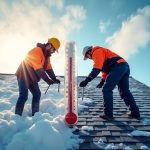
Most attic ladders are meant to be functional: to help reach the space above for HVAC maintenance or access to storage.
If chosen well, an attic ladder offers safe, easy access and supports the building’s design without taking up too much room.
With so many options available, picking the right one can feel overwhelming. This guide helps you choose the ideal attic ladder for your next project, from the right materials and design to practical installation tips.
What Is an Attic Ladder?
Simply put, an attic ladder is a retractable stairway installed in the ceiling to provide safe and convenient entry into an attic space. As opposed to a portable ladder, it is a built-in system that folds away into the ceiling when not in use.
Attic ladders are typically installed within a framed opening and sealed by an insulated door or panel. If one needs to enter the attic, they can unlatch the door using a pole or pull-string so the ladder can extend all the way to the floor.
This design saves space compared to having a full staircase, making it practical for buildings with limited space.
Features To Look for in the Right Attic Ladder
Materials and Durability
The material of an attic ladder has a big impact on its look, durability, and performance. The two most common options are wood and metal, each with its benefits.
- Wooden Ladders: Property owners prefer wood for their classic look, especially in residential spaces. Quality wooden ladders are sturdy enough for such applications. They are, however, heavier than the metal ones, making them harder to install.
Wood is also susceptible to damage by humidity or extreme temperatures, so proper insulation and care are important.
- Metal Ladders: These are usually made from aluminum or steel, and are strong yet relatively lightweight. Aluminum models are particularly light and won’t rust, making them great for humid places like a garage.
Steel ladders are heavier but extremely tough, and are often used for commercial or heavy-duty applications. Their sleek, industrial look can be a deliberate design choice in modern spaces.
Space-Saving Design
The layout of a space determines which ladder design is practical.
- Folding Ladders: These are the most common type. They have two or three sections that fold onto the attic hatch. They are a good fit for most standard applications, as long as there is enough room to unfold below the ceiling.
- Scissor Ladders: These fold up in a tight zig-zag pattern. They are space-efficient and can support a surprising amount of weight.
Attic ladder access doors and panels are key to their final look. Many can be painted to match the ceiling and have flush designs that make them almost invisible when closed.
Safety and Strength Features
For safety, start by choosing a ladder with the right weight capacity. The ladder’s load rating must support the weight of the person climbing and any tools or items they carry.
Most standard ladders can hold between 250 and 350 pounds, but a heavy-duty model is required for frequent use or carrying heavy tools and equipment.
Aside from weight, other key safety features to look for include:
- Handrails: A single or double handrail provides support and stability.
- Non-slip Treads: Steps with a textured surface prevent slips, especially when your hands are full.
- Spring-Assisted Mechanisms: These systems make opening and closing the heavy hatch door easy and safe, preventing it from slamming down or causing accidents.
Installation and Maintenance Tips for Attic Ladders
Even the best ladder needs proper installation and maintenance to last long. This involves precision when framing the ceiling opening, fastening it to the joists, and ensuring everything is level.
Professional installation is always necessary for the best results and to ensure the ladder works safely and smoothly.
Maintenance is simple but important. Property owners should check for loose screws, lubricate hinges, and ensure the treads are clean. The access door should also be checked to ensure a tight seal, which helps with the buildling’s energy efficiency.
Conclusion
Ultimately, the best attic ladder balances the need for safe and proper access with design. By considering materials, space, and safety features, you can select a solution that provides a secure path to the attic and makes it more valuable than ever before.
Whether to maintain mechanical systems housed above or to create more room for storage, attic ladders improve a building’s design and function.








